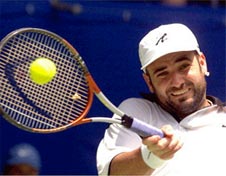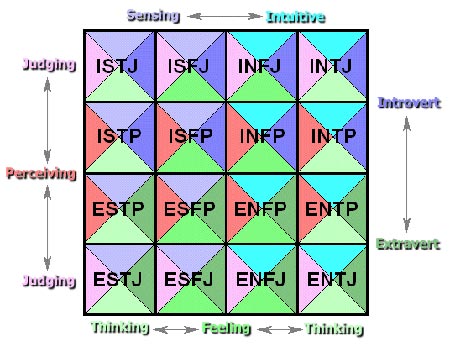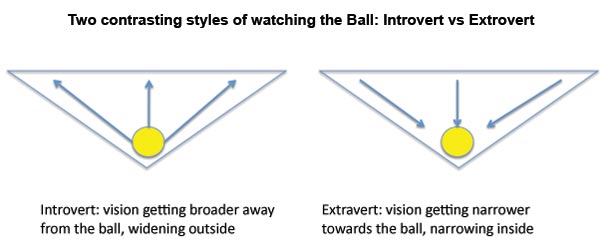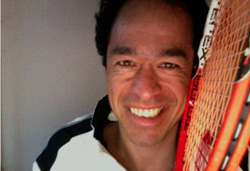|
TennisOne Lessons Don't lose YOUR focus! Jerôme Inen If there is one tennis tip 'right' for everybody, it's to watch the ball, right? Wrong! According to the theory of 'action type' — the idea that every individual has his or her own specific way of coordination — not everyone should watch objects the same way for optimum concentration. A lot of tennis players should NOT watch the ball to perform at their peak… First, I have a little experiment for you, at home, or on the tennis court. It’s best to do it with one or two friends, the more the merrier (I will explain why later). Take three balls and a basket. Or you can take a litterbin and some pieces of crumpled paper, but balls of any kind – golf balls or squash balls – are a little more predictable. Stand at a challenging but not too challenging distance from the basket or bin. Say: ten feet. In a moment, you are going to throw three ‘balls’ to the target, in four series, using four different ‘methods’. Before that, I want to give you a general pointer on concentration, or, as I prefer to call it: focus.
Now try the four ‘methods’.
Now, the most important part of this experiment is not which method is most successful. The most important thing is which method feels right, loose, natural. You will feel it yourself, but your friends (here it comes) will literally laugh with delight because they will see — as clear as day! I learned this simple exercise at a seminar given by Dutch psychologist Jan Huijbers, who once worked with the Dutch volleyball team that won the gold medal at the Olympic Games of Atlanta (1996). The big idea behind this small experiment is called ‘action type’, about which I am going to tell more in due time. First I want to explain why the ‘ball in the basket’ exercise is significant for tennis players.
My general gripe about tennis instruction is the oft repeated suggestion that ‘one size fits all’, for all players. For example ‘always watch the ball’. Or, a new version: keep watching the contact point. How come? Between 2004 and 2008 Roger Federer dominated the ATP tour. Millions of people — fans and coaches alike — tried to discover: what Roger’s secret was? (‘Secret’ is a big thing in tennis instruction. The reader would shudder to see how much spam I get in my mailbox with the header ‘Learn the secrets of the pro’s!’) Then “the secret” was discovered. Federer doesn’t follow the ball with his eyes when he hits it. In the video you can see him at the contact point (and shortly before and after). Roger obviously keeps watching the spot where he contacted the ball. Only then, when the ball is really, really gone his vision starts tracking it again. For comparison: see the video of Novak Djokovic… Thousands of coaches started advising their pupils not to watch the incoming and departing ball, but to keep watching the contact point. I have even met a top hockey player from the Netherlands who told me that the general consensus now among hockey players was: keep looking at the contact point during the hit. Of course I fell for it, too. And of course it did not do me any good. I should have known better. I already knew that visual strategies are determined by your physique and psychology. On top of that, there are other legendary players, equals of Federer, who don’t use his ‘superior’ visual technique. Not Pete Sampras. Not Andre Agassi. Not John McEnroe! Now one could argue that these players have had so much success despite not having Federer's ‘superior visual technique’. But that is a stretch. If I say ‘All swans are white’ you can falsify this statement by finding one black swan… And I can find many black swans… To put an end to it: Roger Federer's visual technique is the best for him… and all the people that are like him. Some people will have success copying Roger — in visual strategy, or other things. But just as many players will only frustrate themselves by imitating him. Because imitation only is helpful when the model and the follower share enough similarities: psychological and physical.
Meyer-Briggs Type Indicator (MBTI) The question of course is: how do you ‘measure’ these similarities? Well, central to the idea of ‘actiontype’ is the Meyer-Briggs Type Indicator (MBTI). This test is based on the work of the famous psychologist Carl Gustav Jung and is used by American firms like Microsoft to assess their employees. I don’t want to delve too deeply, but let me explain the general idea behind the test. The developers of the test believed that the human personality could be divided into four opposing ‘characteristics’. Namely: introvert/extravert, Senses/Intuition, Feeling/Thinking, Perceiving/Judging.
Every person, Jung’s theory says, is always more inclined to one of these character traits. It could be that someone is really introverted (say up to 85 percent), or perhaps more evenly balanced (60-40), but one trait always dominates. So if you fill in a MBTI-test (there are some on the internet, for free, but the best ones are only administered by trained psychologists), you get a certain score. INTJ. Or ESFP. Or INTP. There are sixteen different letter combinations. The idea behind ‘actiontype’ is, for example, that a person with an INTJ-score (Introvert, Intuitive, Thinking, Judging, like the author) needs a totally different kind of focus than a ESFP (Extravert, Sensing, Feeling, Perceiving). Force a ‘ESFP-type’-person to use the focus-type of a ‘INTJ’-type, and he will feel very unhappy indeed! These two types have preferences that are completely opposed! The burning question of course is: if you are able to get a ‘MBTI-test’ somewhere… how do you translate the results to tennis? A word of caution: action type is not a subject of scientific studies. I do not know of any serious scientific, double-blind study of action type in either sports or other disciplines. So that also means: no serious studies about action type and tennis. Jan Huijbers en volleyball coach Peter Murphy wrote a book (in Dutch: Totaalcoachen, Arko Sports Media) about coaching and action type, but do not write about which visual strategies tennis players could or should follow. Still, what is known, can lead us in the right direction. First of all: there have been several scientific studies about focusing in general. And one of the clear findings of those studies is that focusing on something external (meaning: something beyond the body) leads to better results than something internal (meaning: something within your own body).
One example: if you ask people to jump in the air, and you give them a visual cue (a mark on a wall), they will always jump higher than when they concentrate on pushing off on the ground, focus on the strength of their legs or things like that. So: step 1 is taking a visual, external target to focus on. But the little exercise from the beginning of this article is not going to help us. After all: if you throw a ball to a basket, you can watch both the ball and the basket at the same time. With tennis you can’t watch BOTH the ball AND the place you want to hit to. As I mentioned, there has been no serious research into action type and tennis. But the last couple of years I have been able to do some trials that could give us an idea. First of all, I tried both the ‘throw the ball to the basket’ exercise with about twenty of my tennis pupils. About half of them also were so kind as to fill in the MBTI-test and experiment with several visual techniques. On top of that, I have been very fortunate that for the last three years, I could ‘force’ my students at the master of arts-college where I teach to do a seminar that includes both filling in a MBTI-test and play tennis for an afternoon — while testing several visual strategies. So all in all, I have been able to test my ideas about ‘action type’ and tennis with about 100 people. Not scientific in any way, but… it is a start. In a moment, I will give a short overview of the different types and their different focus-methods. First I want to mention a couple of things that keep coming back (and on which I would dare to place a substantial bet.)
Confusing, perhaps. Intuitively, one would say that a focus type should ‘fit’ your character. In that view, someone who is extravert, outgoing, ‘open’ for the world, should focus on a broad visual field (for example: the whole tennis court). The few coaches who have worked with ‘action type’ will tell you that the opposite is true: an extravert person should focus on a real small visual target. How is this possible? Let’s put it this way: concentration is focus on a goal. The idea behind ‘action type’ is to ‘lock’ your attention. For that you need a visual strategy that ‘forces’ you to use a way of watching that is totally opposed to your usual way of watching. Concentration is focus forced on a goal.
An example. Say you have a cluttered desk. Somewhere, around, are your keys. If an introvert person tries to find his keys with his nose an inch above the desk, he will never find them. Because during his hunt, he will see small objects that distract him (papers, paperclips, pens, cables, business cards), things that get his thinking brain going, take him ‘out of the world’ and into his head. And take his thoughts away from his keys.
What an introvert person should do is take a good distance from his desk, and then ‘scan’ his desk, globally. Then he will find his keys. While an extravert person who does the same, look from a distance, will jump visually from object to object on the desk. And never find his keys! He should put his nose right above the desk. How does that apply to tennis? Someone who is extravert should try to find a visual focus that is as small as possible. Indeed, the contact point. Or perhaps a focus point that is even closer. Something really close to the body, but, as I said before: always external. I have never met someone who could improve his focus by directing his attention to movements of his body. Here I will sum up the visual strategies I have formulated in the past years with my students, from extravert to more and more introvert.
An introverted person should have a broad visual focus. He should see and be aware of the whole court and at least a part of his attention should be on the other side of the net. An extravert person should be, visually, more on his or her side of the net. One could say that his ‘arena of action’ is pretty small. While the ‘arena of action’ for the introvert person is pretty big. But caution: both players should of course see the ball! If you don’t know where the ball is, tennis will be very hard. But as Scott Ford in his excellent articles on the Parallel Mode has shown, there is a difference between staring at a ball (watching it intently) and seeing the ball arrive from the corners of your eyes. Again, unfortunately, there is no serious research into this fascinating subject. But I am convinced that tennis players could gain a lot from exploring the idea of ‘action type’. At the seminars with my students, me and my fellow teachers (of which one is a child-psychologist), were sometimes stunned how well the students suddenly started to play when we asked them to use the visual strategy ascribed to their respective ‘action type’. Once one of my students, a girl, could not get a ball over the net. And I mean: literally not over the net. I asked her which visual strategy she was following. ‘I keep watching the contact point.’ I did a quick think, and said: ‘That is a visual strategy for an extraverted person.’ Yes, she said, the first letter in her MBTI-test was an ‘E’, for Extravert. My colleague and I said in unison (because we knew this girl well): ‘You, an extravert? You are the introvert to end all introverts!’ I advised the girl to see the whole court, to focus on the other side of the net, far away from her… and she hit all of the next three balls inches from the target. Not only that, we could see her body transform. She moved differently, easily, more naturally. It was her movement, while the first movements looked like those of a marionette controlled by a lousy puppeteer. What is best for you, you have to discover for yourself. If there are indeed 16 different ‘action types’ (as Jung suggests!) there have to be at least 16 different visual strategies of focusing! Personally, I think there probably are 256 visual strategies, but I am not going to bore you to death by describing them all. Go to a tennis court with some balls; put some goals on the court and experiment. Don’t be the puppet of imitation, but the puppeteer of your own creations! Your comments are welcome. Let us know what you think about Jerôme Inen's article by emailing us here at TennisOne.
"I’ve learned tennis the traditional, form-oriented way — and it is not the right way! Lijftennis is my attempt to show other people a way to learn quicker, with better results and less frustration. If I have one message: don’t copy others, play and learn from your own body and perspective!" |






 Jerôme Inen of
Jerôme Inen of